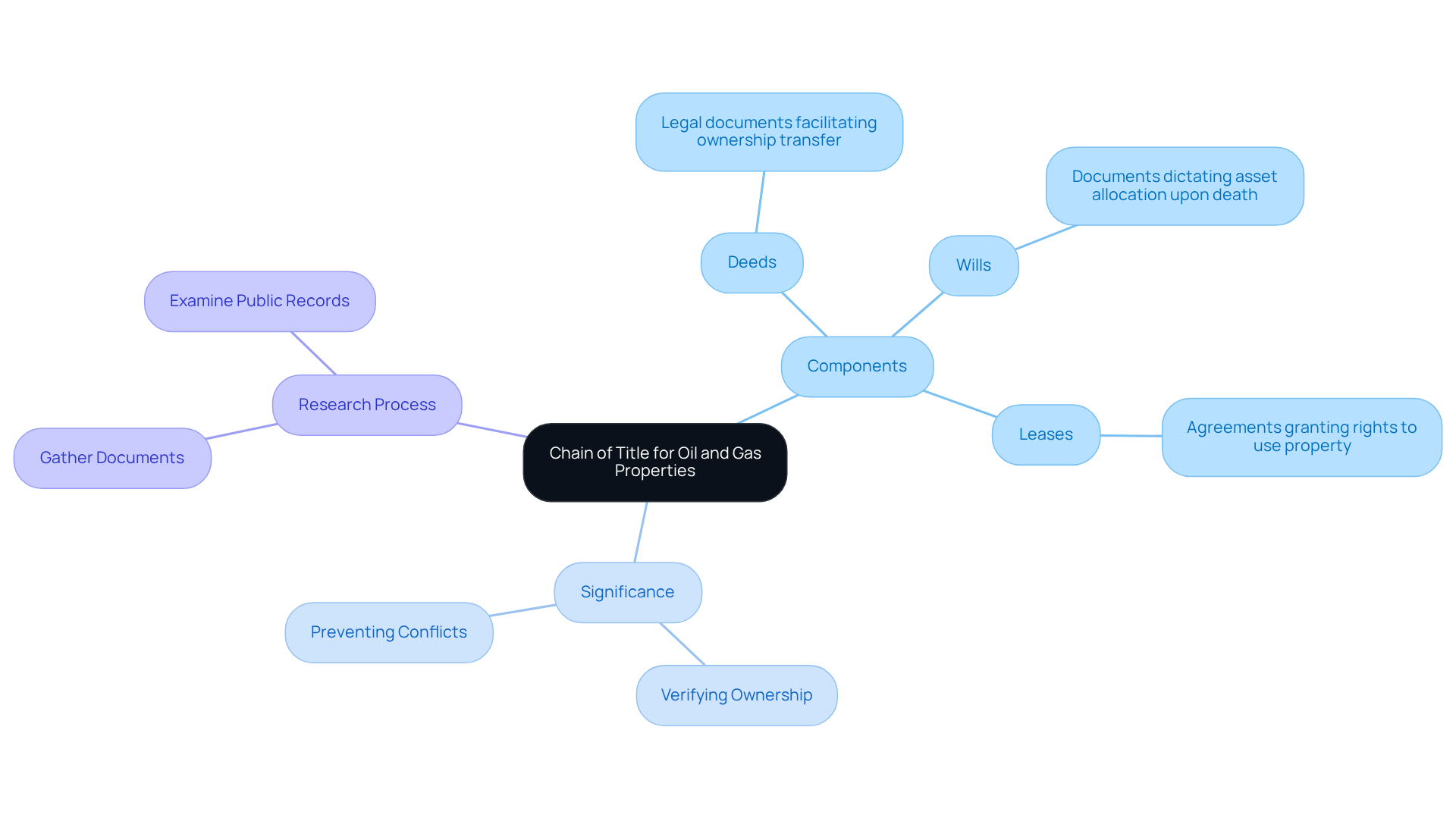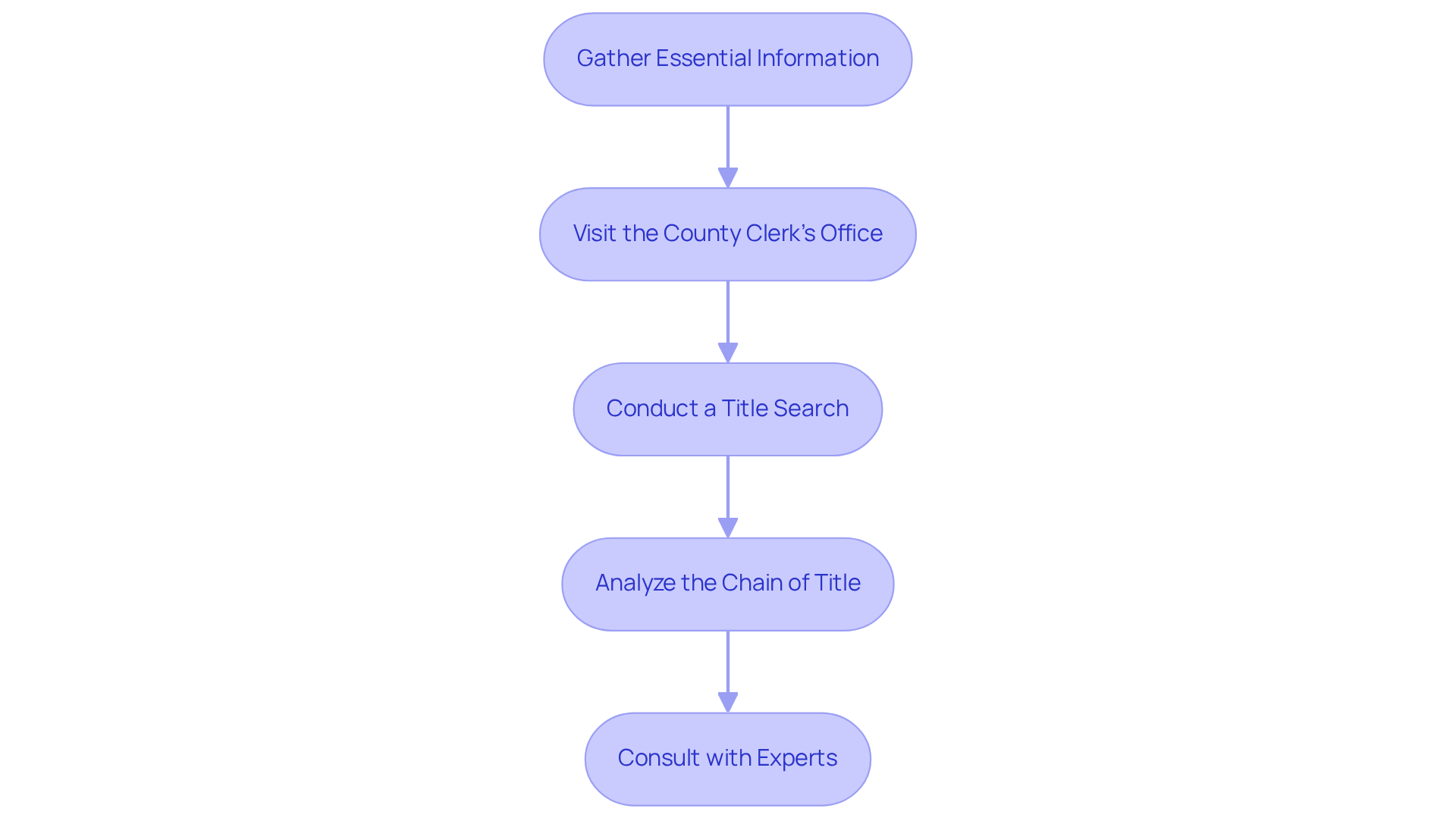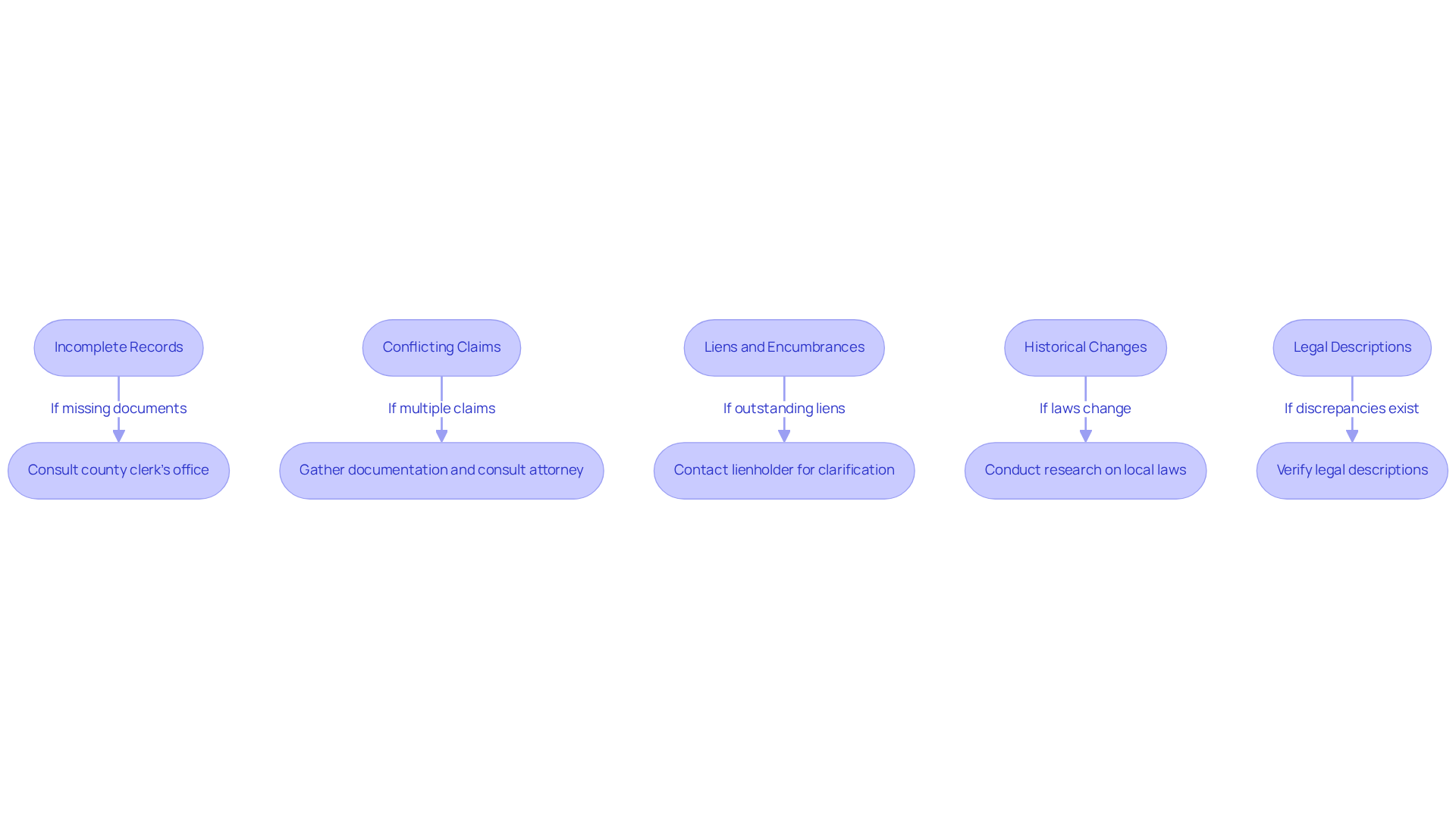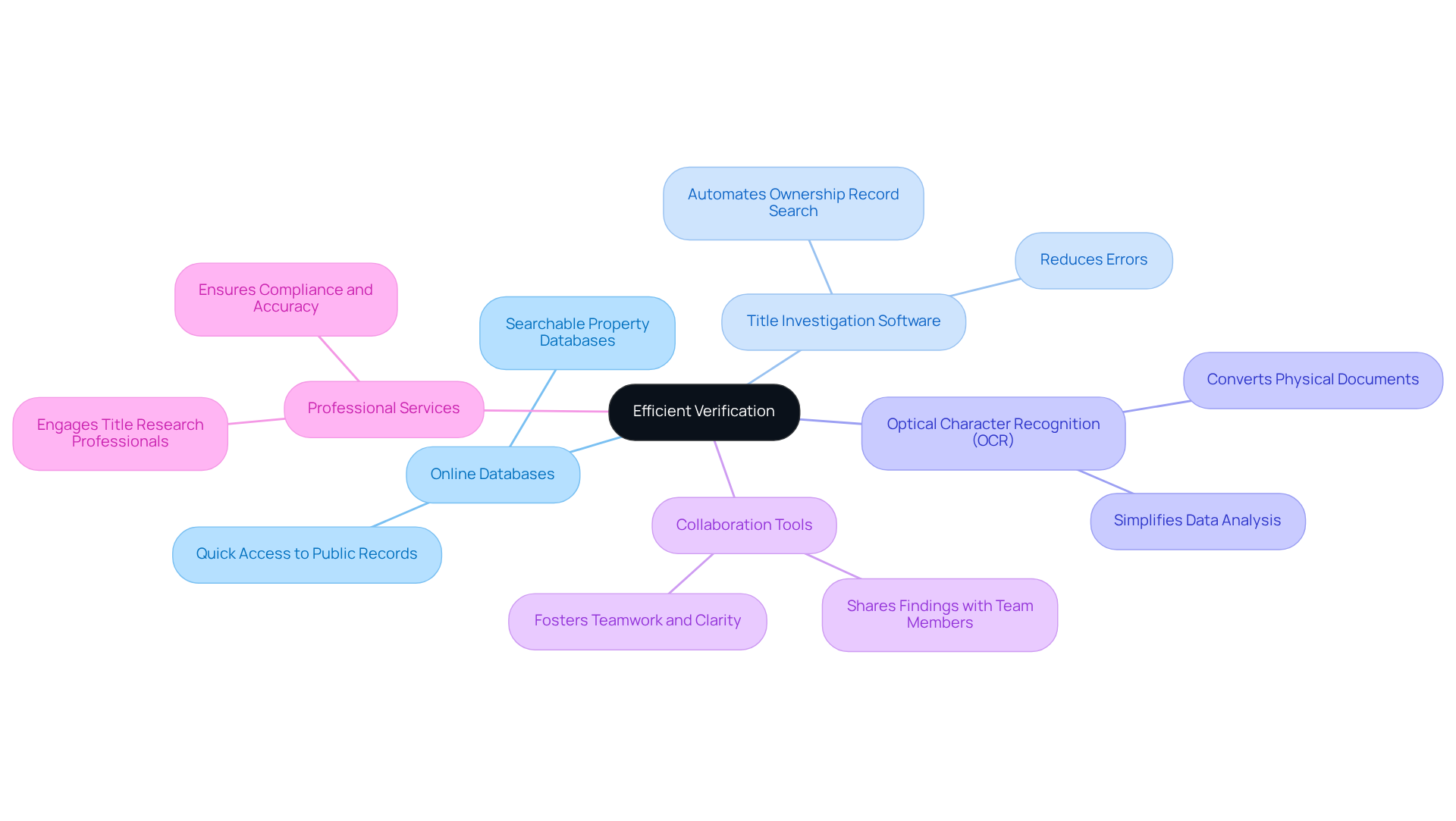Overview
Verifying the chain of title for oil and gas properties is a critical process that involves several essential steps.
- First, it is imperative to gather the necessary documents.
- Following this, a thorough title search must be conducted to ensure accuracy.
- If challenges arise, consulting with experts is advisable to navigate complexities effectively.
This article outlines a systematic approach, underscoring the significance of understanding the various types of legal documents involved. Furthermore, the use of technology is emphasized as a means to enhance the efficiency and accuracy of the verification process, ultimately reinforcing the reliability of the solutions offered.
Introduction
Understanding the chain of title is paramount for anyone engaged in oil and gas properties, as it establishes the foundation for ownership verification and conflict prevention. This guide elucidates the essential steps necessary to navigate the complexities of title verification, from gathering pivotal documents to leveraging advanced technology for efficient research. Furthermore, what occurs when discrepancies arise, or when multiple claims contest the established chain? Exploring these challenges and their resolutions will illuminate the path to secure and reliable ownership verification in the oil and gas sector.
Understand the Chain of Title
The historical series of transfers of possession of a property, including oil and gas rights, is known as the chain of title for oil and gas properties. This process is documented through various legal instruments such as deeds, wills, and leases. Understanding the chain of title is essential for several reasons:
-
Components of the Chain: It is crucial to familiarize yourself with the types of documents involved, which include:
- Deeds: These legal documents facilitate the transfer of ownership.
- Wills: These documents dictate the allocation of assets upon the death of the owner.
- Leases: These agreements grant rights to use the property.
-
The chain of title for oil and gas properties is essential for verifying ownership. The significance of a clear chain of title for oil and gas properties is vital for verifying possession and preventing potential conflicts. It should illustrate continuous possession in the chain of title for oil and gas properties from the original land grant to the current holder.
-
Researching the Chain: Start by gathering all pertinent documents related to the asset. This process involves examining public records and understanding the historical context of title transfers.

Steps to Verify the Chain of Title
To verify the chain of title for oil and gas properties, it is essential to follow these steps:
-
Gather Essential Information: Begin by compiling the legal description of the asset, including its location and any prior title details.
-
Visit the County Clerk's Office: Go to the local county clerk's office where the land is situated. Request access to public records, including:
- Deeds: Look for the most recent deed and work backward through previous deeds.
- Wills and Probate Records: Check for any wills that may affect ownership.
-
Conduct a Title Search: Perform a thorough title search by examining:
- Recorded Documents: Review all recorded documents related to the property. Utilize Parse AI's , including the example manager, to expedite document processing and interpretation, allowing for efficient extraction of critical information from title documents.
- Tax Records: Verify that property taxes have been paid and check for any liens.
-
Analyze the chain of title for oil and gas properties by creating a timeline of ownership transfers. Ensure that each transfer is documented and that there are no gaps in the chain. Utilize the digital interface offered by Parse AI for searching county clerk records, which enables you to conduct full-text searches and access detailed information obtained from files without redundancy.
-
Consult with Experts: If you face complications or doubts, consider employing a landman or legal advisor to assist with the verification process. Their knowledge, combined with Parse AI's automated processing capabilities, can guarantee a comprehensive and precise verification of ownership.

Troubleshoot Common Title Verification Issues
When confirming the for oil and gas properties, several common issues may arise. Understanding how to troubleshoot these challenges is essential for successful title research.
- Incomplete Records: Should you encounter missing documents, it is advisable to consult the county clerk's office for any unrecorded transactions or potential filing errors.
- Conflicting Claims: In instances where multiple parties assert possession, gather all relevant documentation and seek counsel from a title attorney to clarify rights.
- Liens and Encumbrances: If outstanding liens exist, ensure they are resolved prior to any transactions. Contact the lienholder for necessary clarification.
- Historical Changes: Remain informed about modifications in real estate laws or regulations that may affect rights of possession. Conduct thorough research on local laws to ensure compliance.
- Legal Descriptions: Verify that the legal descriptions in documents correspond with the property in question. Discrepancies can lead to significant issues in ownership verification.

Utilize Technology and Resources for Efficient Verification
To enhance the efficiency of verifying the chain of title, it is crucial to utilize advanced technologies and resources.
- Online Databases: Access public records quickly through online property databases. Websites like county assessor's offices often provide that streamline the research process.
- Title Investigation Software: Investing in investigation software can automate the search and organization of ownership records. This not only saves time but also significantly reduces errors, enhancing overall accuracy.
- Optical Character Recognition (OCR): Implement OCR technology to convert and retrieve information from physical documents. This simplifies the analysis of substantial amounts of record data, making the verification process more efficient.
- Collaboration Tools: Leverage collaboration platforms to share findings with team members or legal advisors. This ensures that everyone remains aligned during the verification process, fostering teamwork and clarity.
- Professional Services: Consider engaging title research professionals who utilize advanced technologies to conduct thorough and efficient title searches. Their expertise ensures compliance and accuracy, ultimately reinforcing the reliability of your title verification efforts.

Conclusion
Understanding the chain of title for oil and gas properties is essential for establishing clear ownership and preventing disputes. This guide emphasizes the critical nature of this historical record, which encompasses ownership transfers through various legal documents, including deeds, wills, and leases. By verifying the chain of title, property owners can assert their rights and mitigate potential conflicts stemming from ambiguous ownership.
Key steps for verifying the chain of title involve:
- Gathering essential information
- Visiting the county clerk's office for public records
- Conducting a comprehensive title search
- Consulting with experts as needed
Furthermore, this article addresses common issues that may arise during the verification process, such as incomplete records and conflicting claims, while offering strategies to troubleshoot these challenges. Utilizing technology and resources, including online databases, title investigation software, and professional services, can significantly enhance the efficiency and accuracy of the verification process.
Ultimately, verifying the chain of title for oil and gas properties transcends mere procedural necessity; it is foundational for securing ownership rights and ensuring compliance with legal standards. By adhering to the outlined steps and leveraging available technologies, property owners and stakeholders can adeptly navigate the complexities of title verification, thereby reinforcing their position within the oil and gas industry. The importance of a clear and verified chain of title is paramount, serving as the backbone of property rights and transactions in this vital sector.
Frequently Asked Questions
What is the chain of title for oil and gas properties?
The chain of title for oil and gas properties refers to the historical series of transfers of possession of a property, including oil and gas rights, documented through legal instruments such as deeds, wills, and leases.
Why is understanding the chain of title important?
Understanding the chain of title is essential for verifying ownership, illustrating continuous possession, and preventing potential conflicts regarding property rights.
What are the main components of the chain of title?
The main components of the chain of title include deeds (which transfer ownership), wills (which dictate asset allocation upon the owner's death), and leases (which grant rights to use the property).
How can one research the chain of title for oil and gas properties?
Researching the chain of title involves gathering all pertinent documents related to the asset, examining public records, and understanding the historical context of title transfers.




